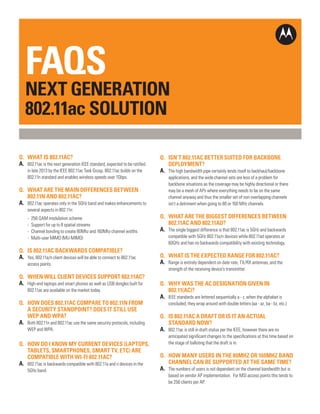
802 11ac fa_qs
- 1. CHANNEL FAQs FACT SHEET FAQS NEXT GENERATION 802.11ac SOLUTION Q. WHAT IS 802.11AC? A. 802.11ac is the next generation IEEE standard, expected to be ratified in late 2013 by the IEEE 802.11ac Task Group. 802.11ac builds on the 802.11n standard and enables wireless speeds over 1Gbps. Q. WHAT ARE THE MAIN DIFFERENCES BETWEEN 802.11N AND 802.11AC? A. 802.11ac operates only in the 5GHz band and makes enhancements to several aspects in 802.11n: - 256 QAM modulation scheme - Support for up to 8 spatial streams - Channel bonding to create 80Mhz and 160Mhz channel widths - Multi-user MIMO (MU-MIMO) Q. IS 802.11AC BACKWARDS COMPATIBLE? A. Yes, 802.11a/n client devices will be able to connect to 802.11ac access points. Q. WHEN WILL CLIENT DEVICES SUPPORT 802.11AC? A. High-end laptops and smart phones as well as USB dongles built for 802.11ac are available on the market today. Q. A. HOW DOES 802.11AC COMPARE TO 802.11N FROM A SECURITY STANDPOINT? DOES IT STILL USE WEP AND WPA? Q. A. Both 802.11n and 802.11ac use the same security protocols, including WEP and WPA. HOW DO I KNOW MY CURRENT DEVICES (LAPTOPS, TABLETS, SMARTPHONES, SMART TV, ETC) ARE COMPATIBLE WITH WI-FI 802.11AC? 802.11ac is backwards compatible with 802.11a and n devices in the 5GHz band. Q. ISN’T 802.11AC BETTER SUITED FOR BACKBONE DEPLOYMENT? A. The high bandwidth pipe certainly lends itself to backhaul/backbone applications, and the wide channel sets are less of a problem for backbone situations as the coverage may be highly directional or there may be a mesh of APs where everything needs to be on the same channel anyway and thus the smaller set of non-overlapping channels isn’t a detriment when going to 80 or 160 MHz channels. Q. WHAT ARE THE BIGGEST DIFFERENCES BETWEEN 802.11AC AND 802.11AD? A. The single biggest difference is that 802.11ac is 5GHz and backwards compatible with 5GHz 802.11a/n devices while 802.11ad operates at 60GHz and has no backwards compatibility with existing technology. Q. WHAT IS THE EXPECTED RANGE FOR 802.11AC? A. Range is entirely dependent on date rate, TX/RX antennas, and the strength of the receiving device’s transmitter. Q. WHY WAS THE AC DESIGNATION GIVEN IN 802.11(AC)? A. IEEE standards are lettered sequentially a - z, when the alphabet is concluded, they wrap around with double letters (aa - az, ba - bz, etc.) Q. IS 802.11AC A DRAFT OR IS IT AN ACTUAL STANDARD NOW? A. 802.11ac is still in draft status per the IEEE, however there are no anticipated significant changes to the specifications at this time based on the stage of balloting that the draft is in. Q. HOW MANY USERS IN THE 80MHZ OR 160MHZ BAND CHANNEL CAN BE SUPPORTED AT THE SAME TIME? A. The numbers of users is not dependent on the channel bandwidth but is based on vendor AP implementation. For MSI access points this tends to be 256 clients per AP. PAGE 1
- 2. CHANNEL FAQs SHEET PRODUCT FAQ FACT SHEET NEXT GENERATION 802.11AC SOLUTION Q. DOES 11AC HELP IMPROVE THE PERFORMANCE OF 11N DEVICES IN ANY WAY? A. 802.11ac technology itself does not improve the performance of 802.11n devices, however improvements in chipsets as well as receiver technology advancements made in the development of 802.11ac may result in mild improvements for 11n clients in some environments. Q. WHEN WILL THE NEW 802.11AC ACCESS POINTS BE SHIPPING? A. The AP 8232 and AP 8222 ship in Q4 2013. Q. WHAT ARE THE DIFFERENCES BETWEEN THE AP 8232 AND AP 8222? A. The AP 8232 is a dual radio 802.11n/802.11ac access point with an expandable design to support plug-in USB modules. The AP 8222 is also a dual radio design, but with a fixed configuration with and internal antennas in an aesthetically pleasing housing. Q. WHAT APPLICATION MODULES ARE BEING MADE AVAILABLE? A. There will be a WIPS sensor radio module and a 3G/4G/LTE backhaul module available in Q3. Additional modules such as an environmental sensor module and video camera module will follow later in 2013. Q. HOW MANY SPATIAL STREAMS DOES THE AP 8232 SUPPORT? A. The AP 8232 is a 3x3 MIMO design with 3 spatial streams. Q. CAN I OPERATE THE AP 8232/AP 8222 AT 802.11AC OFF 802.3AF POWER? A. Yes, there will be a configurable mode of operation that allows for 802.11ac operation while running on 3af power. Q. IS THE AP 8232 PLENUM RATED? A. Yes, the external antenna AP 8232 is plenum rated. Q. WHAT IS HIERARCHICAL MANAGEMENT? A. Hierarchical management provides a single dashboard in WiNG, available on the NX 9500 controller platform, that allows management of remote controllers, APs, WIPS and other applications all from an integrated easy-to-use, graphical console. It also delivers centralized control over the enterprise Wi-Fi deployment. Q. HOW DOES APPLICATION ACCELERATION WORK? A. Application acceleration provides real-time caching of content with the NX 4500/6500 Integrated Service Platforms, improving web browsing and mobile app experiences for shoppers and guests without requiring a major upgrade to the WAN infrastructure. Q. HOW MANY RADIOS DOES THE AP 8232 HAVE? A. The AP 8232 is a dual-radio design, one radio supporting 802.11a/b/g/n Q. A. CAN YOU ADDRESS THE SPECIFICS ON HOW THE MULTIPLE USER MIMO WORKS — E.G. “ALLOWS MULTIPLE STREAMS TO BE ASSIGNED TO DIFFERENT CLIENTS”? Q. CAN I USE THE AP 8132 MODULES WITH THE AP 8232? A. Yes, AP 8132 modules are compatible with the AP 8232. and the other supporting 802.11ac. This allows customers to support new mobile devices as well as legacy clients. MU-MIMO allows for a certain amount of parallelism in how data is transmitted to client devices improving system throughput and performance over a traditional MIMO system. Printed in USA 10/13. MOTOROLA, MOTO, MOTOROLA SOLUTIONS and the Stylized M Logo are trademarks or registered trademarks of Motorola Trademark Holdings, LLC and are used under license. All other trademarks are the property of their respective owners. ©2013 Motorola Solutions, Inc. All rights reserved. PAGE 2
